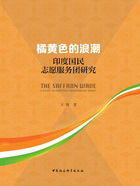
五 主要内容与结构安排
本书主要运用社会运动理论分析国民志愿服务团参与和影响印度社会政治发展的过程,以印度社会政治发展以及国民志愿服务团产生和发展的重要时期划分主要章节。除导论外还包括七部分,主要内容和结构安排如下。
第一章梳理社会运动研究的基本脉络,对社会运动等核心概念进行界定,同时,重点阐释政治机会、资源动员与框架建构三大要素,社会运动与政党的互动关系,在此基础上构建本书的理论解释框架。第二章聚焦国民志愿服务团的历史与现状,主要梳理基本情况、组织运行与主要分支。由于国内学界对国民志愿服务团的关注和研究相对不足,因此有必要对相关背景知识进行概要性的介绍。第三、第四、第五章主要运用社会运动理论的解释框架展开分析,包括组织成立与发展建设初期、组织转型与团家族形成时期、激进主义与政治崛起时期三个关键历史时期。三个时期分别以政治机会、资源动员和框架建构三大要素为线索,具体解释国民志愿服务团是如何产生并发展壮大,在不同历史时期是如何参与印度政治过程的。第六章主要分析印度人民党执政时期国民志愿服务团对内政和外交的影响。该章以国民志愿服务团与印度人民党的互动关系为切入点,选取印度人民党的两次执政经历——瓦杰帕伊政府时期和莫迪政府时期进行比较分析,探讨国民志愿服务团对印度内政与外交的主要影响。第七部分为结论,简要阐述本书关于国民志愿服务团的研究发现和启示,对社会运动研究和理论的贡献,并指出研究的不足之处与未来的研究方向。
[1]橘黄色(Saffron)是印度教的标识颜色,学界通常把印度教民族主义对印度社会政治的渗透和影响称为橘黄色化(Saffronisation)。
[2]胡仕胜、王珏:《印度对华示强外交的行为逻辑》,《现代国际关系》2020年第7期。
[3]为表述简洁,本书将统一使用“国民志愿服务团”指代“印度国民志愿服务团”。
[4]国民志愿服务团在早期发展中不注重甚至避免对外宣传,因此,公开的出版物较少。相关出版物主要出现在20世纪70年代之后,参见Jagat S.Bright,Guruji Golwalkar&R.S.S.: India's Man of Destiny and His Mighty Movement, New Delhi: New India Publishing,1972; Rashtriya Swayam-sevak Sangh,RSS: A Bird's Eye View, Banglore: Prakashan Vibhag,1978; Balasahab Deoras,Hindu Sangathan: The Need of the Nation, New Delhi: Suruchi Sahitya,1979。
[5]参见 Govind Sahai,R.S.S.: Ideology,Technique,Propaganda, Delhi: Naya Hindustan Press,1956; Subhadra Joshi ed.,RSS: A Danger to Democracy, New Delhi: Sampradayikta Virodhi Committee,1967; Ram Lall Dhooria,I Was a Swayamsevak: An Inside View of The RSS, New Delhi:Sampradayikta Virodhi Committee,1969; Eklavya,How RSS Is Financed, New Delhi: Sampradayikta Virodhi Committee,1971; K.L.Mahendra,Defeat the RSS Fascist Designs, New Delhi: Communist Party Publication,1977。
[6]D.R.Goyal,Rashtriya Swayamsevak Sangh, New Delhi: Radhakrishna Prakashan,1979.
[7]参见Yogendra K.Malik and V.B.Singh,Hindu Nationalism in India: The Rise of Bharatiya Janata Party, New Delhi: Vistaarr,1994; Partha S.Ghosh,BJP and the Evolution of Hindu National-ism: From Periphery to Centre, New Delhi: Manohar,1999; C.P.Bhambhri,Bharatiya Janata Party:Periphery to Centre, New Delhi: Shipra Publications,2001。
[8]A.G.Noorani,The RSS and The BJP: A Division of Labour, New Delhi: Left Word,2000.
[9]Pralay Kanungo,RSS's Tryst with Politics: From Hedgwar to Sudarshan, New Delhi: Mano-har,2017.
[10]Shamsul Islam,Religious Dimensions of Indian Nationalism: A Study of RSS, New Delhi:Media House,2006.
[11]Kingshuk Nag,The Saffron Tide: The Rise of The BJP, New Delhi: Rupa Publications,2014.
[12]Suchitra Kulkarni,RSS-BJP Symbiosis: On the Cusp of Culture and Politics, New Delhi: Prab-hat Prakashan,2017.
[13]Saba Naqvi,Shades of Saffron: From Vajpayee to Modi, New Delhi: Westland Publications,2018.
[14]A.G.Noorani,The RSS: A Menace to India, New Delhi: LeftWord Books,2019.
[15]Dinesh Narayanan,The RSS and the Making of the Deep Nation, New Delhi: Penguin Viking,2020.
[16]Partha Banerjee,In the Belly of the Beast: The Hindu Supremacist RSS and BJP of India an Insider's Story, New Delhi: Ajanta Books International,1998.该书作者曾加入国民志愿服务团并与之保持联系20年左右,最终选择退出。
[17]20世纪90年代国民志愿服务团成员的研究文献,还可参见 H.V.Seshadri,The Way, New Delhi: Suruchi Prakashan,1991; K.R.Malkani,How Others Look at The R.S.S., New Delhi:Deendayal Research Institute,1992。
[18]Sanjeev Kelkar,Lost Years of the RSS, New Delhi: Sage Publications,2011.
[19]参见 Ratan Sharda,RSS 360: Demystifying Rashtriya Swayamsevak Sangh, New Delhi:Bloomsbury India,2018; Arun Anand,The Saffron Surge: Untold Story of RSS Leadership, New Delhi:Prabhat Paperbacks,2019; Nilanjan Mukhopadhyay,The RSS: Icons of the Indian Right, New Delhi:Tranquebar,2019; Sunil Ambekar,The RSS: Roadmaps for the 21st Century, Rupa Publications India,2019。
[20]Jean Alonzo Curran,Militant Hinduism in Indian Politics: A Study of the R.S.S., New York:Institute of Pacific Relations,1951.
[21]Walter Andersen,“The Rashtriya Swayamsevak Sangh: I: Early Concerns.”Economic and Political Weekly, Vol.7,No.11,1972,pp.589-597; WalterAndersen,“The Rashtriya Swayamsevak Sangh: Ⅱ: Who Represents the Hindus?”Economic and Political Weekly, Vol.7,No.12,1972,pp.633-640; Walter Andersen,“The Rashtriya Swayamsevak Sangh: Ⅲ: Participation in Politics.”Economic and Political Weekly, Vol.7,No.13,1972,pp.677-682; Walter Andersen,“The Rash-triya Swayamsevak Sangh: IV: Jan Sangh and Other Organisations.”Economic and Political Weekly, Vol.7,No.14,1972,pp.724-727.
[22]Walter K.Andersen and Shridhar D.Damle,The Brotherhood in Saffron: The Rashtriya Sway-amsevak Sangh and Hindu Revivalism, New Delhi: Vistaar Publications,1987.
[23]Christophe Jaffrelot,The Hindu Nationalist Movement and Indian Politics: 1925 to 1990s, New Delhi: Penguin Books,1999.
[24]Peter van der Veer,Religious Nationalism: Hindus and Muslims in India, New Delhi: Oxford University Press,1996.
[25]Thomas Blom Hansen and Christophe Jaffrelot,eds.,The BJP and the Compulsions of Politics in India, New Delhi: Oxford University Press,1998.
[26]Thomas Blom Hansen,The Saffron Wave: Democracy and Hindu Nationalism in Modern India, Princeton: Princeton University Press,1999.
[27]Christophe Jaffrelot ed.,The Sangh Parivar: A Reader, New Delhi: Oxford University Press,2005.
[28]Christophe Jaffrelot ed.,Hindu Nationalism: A Reader, Ranikhet: Permanent Black,2019.
[29]Christophe Jaffrelot,Religion,Caste,and Politics in India, New Delhi: Primus Books,2010.
[30]Walter K.Andersen and Shridhar D.Damle,The RSS: A View to the Inside, New Delhi: Pen-guin Viking,2018.
[31]Angana P.Chatterji,Thomas Blom Hansen and Christophe Jaffrelot,eds.,Majoritarian State:How Hindu Nationalism Is Changing India, New Delhi: HarperCollins Publishers India,2019.
[32]江亦丽:《橘黄旗下的联盟——印度教教派组织国民志愿服务团(RSS)剖析》,《南亚研究》1994年第2期。
[33]刘静:《印度国民志愿服务团》,《当代世界》1999年第5期。
[34]比较有代表性的文献参见邱永辉《印度教、民族主义与印度人民党》,《南亚研究季刊》1998年第4期;朱明忠《印度教民族主义的兴起与印度政治》,《当代亚太》1999年第8期;周陈《试析20世纪80年代印度教民族主义的政治复兴》,《南亚研究季刊》2004年第2期;宋丽萍《印度人民党研究述略》,《世界历史》2004年第2期;宋丽萍《试析印度人民党的双重属性》,《当代世界社会主义问题》2005年第4期;宋丽萍《印度人民党意识形态的发展变化》,《唐都学刊》2008年第6期;陈金英《价值与工具:印度人民党意识形态诉求的政治学分析》,《武汉大学学报》(哲学社会科学版)2008年第5期;傅菊辉、汪长明《印度教民族主义对南亚国际关系的影响》,《世界民族》2009年第2期。
[35]比较有代表性的文献参见陈小萍《从印度人民党的选举战略看莫迪政府政策走向》,《南亚研究季刊》2014年第2期;陈金英《莫迪执政以来印度人民党的扩张及其原因》,《当代世界》2018年第5期;陈小萍《印度教民族主义与独立后印度政治发展研究》,时事出版社2015年版。
[36]比较有代表性的文献参见王娟娟《冷战后印度政党格局与政党政治:历史经验与未来走向》,《南亚研究季刊》2019年第3期;王瑞领《论莫迪执政以来印度外交政策的调整——基于印度政治发展的视角》,《南亚研究》2019年第4期;宋丽萍《印度教特性运动的政治文化解读》,《南亚研究》2019年第4期;王世达《印度教民族主义强势崛起及其影响》,《现代国际关系》2020年第2期;许娟《宗教政治化:印度教民族主义的再次兴起及其对印度外交的影响》,《南亚研究》2020年第2期;杨新天《印度人民党意识形态的适应性演变及其成效分析》,《南亚研究》2020年第2期;冯立冰《莫迪执政以来印度人民党的组织资源与动员策略》《南亚研究》2020年第4期。
[37]谢代刚:《印度国民志愿服务团研究》,巴蜀书社2016年版;刘嘉伟:《印度社会政治发展与印度国民志愿服务团》,四川美术出版社2018年版。
[38]曾祥裕、张春燕:《印度人民党与印度国民志愿服务团:协调、分歧与未来走向》,《南亚研究季刊》2017年第4期。
[39]刘思明:《社会运动与印度人民党的发展》,硕士学位论文,南京大学,2016年。
[40]王凯:《印度国民志愿服务团对莫迪政府决策的影响——基于社会运动制度化的视角》,《南亚研究季刊》2020年第3期;王凯:《社会运动、委托代理与印度人民党的行动逻辑》,《南亚研究》2021年第1期。
[41]赵鼎新:《社会与政治运动讲义》,社会科学文献出版社2012年版,第2—4页。
[42]赵鼎新:《社会与政治运动讲义》,第2页。
[43]叶海林:《身份认知偏差对中印关系前景的影响》,《印度洋经济体研究》2020年第3期。
[44]叶海林:《中国崛起与次要战略方向挑战的应对——以洞朗事件后的中印关系为例》,《世界经济与政治》2018年第4期。